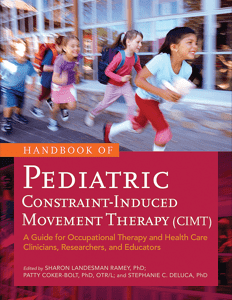Abstract
Scientific findings strongly support pediatric CIMT as a treatment strategy that can—and often does—produce measurable benefits to children with impairment in use of their upper extremities. The timely publication of the Handbook of Pediatric Constraint-Induced Movement Therapy (CIMT) provides an integrative history about CIMT that includes its major research findings, theoretical underpinnings, practical guidelines for practitioners and health care providers, and peer-reviewed information for students preparing to be pediatric practitioners and educators.
This handbook also features an extensive evidence table related to pediatric CIMT and writable forms for documenting pediatric CIMT for clinical practice or research.
Drawing on decades of evidence and clinical experience, this book is the most comprehensive text available on constraint therapy for children.
Details
Table of Contents
Handbook of Pediatric Constraint-Induced Movement Therapy (CIMT)
-
Front Matter
i2

- Section I. Theory and History of CIMT for Children With Cerebral Palsy 234
-
1. History and Development of CIMT for Adults With Stroke
436

-
2. Pediatric CIMT: History and Definition
2052

-
3. Applying Occupation and Motor Learning Principles in Pediatric CIMT: Theoretical Foundations and Conceptual Framework
4274

-
4. Motor Development and Physical Growth in Children With Cerebral Palsy
5688

-
5. Muscle Structural Adaptation in Cerebral Palsy and Relationship to Function
74106

-
6. Assessment Tools to Measure Upper-Limb Function and Impact of Therapy
90122

-
1. History and Development of CIMT for Adults With Stroke
436
- Section II. Clinical Applications, Protocols, and Individualization 114146
-
7. Operationalizing Pediatric CIMT: Guidelines for Transforming Basic Principles and Scientific Evidence Into Clinical Practice for Individual Children
115147

-
8. The ACQUIREc Protocol: What We Have Learned From a Decade of Delivering a Signature Form of Pediatric CIMT
130162

-
9. Alternative Pediatric CIMT: Understanding the How and Why of Clinical Variations in Pediatric CIMT
150182

-
10. Group-Based Models of Pediatric CIMT: Special Camps, School-Based Treatment, and Home EnvironmentModels
161193

-
11. Adapting Pediatric CIMT for Children With Brachial Plexus Injuries, Traumatic Brain Injury, and Hemispherectomy and OtherSurgical Interventions
182214

-
12. Novel and Complementary Therapy Strategies: Critical Issues and Opportunities for Combining With Pediatric CIMT
200232

-
13. Intensive Bimanual Training Approaches to Upper-Extremity Rehabilitation in Children With Cerebral Palsy
222254

-
14. Beyond Upper-Extremity Benefits of Pediatric CIMT: Reported Changes in Gait and Other Neuromotor Skills
236268

-
7. Operationalizing Pediatric CIMT: Guidelines for Transforming Basic Principles and Scientific Evidence Into Clinical Practice for Individual Children
115147
- Section III. Collaboration and Coordination With Families and Other Professionals 248280
- Section IV. Future for Research, Policy, and Practice 266298
-
Key Findings From Original Research Articles With Functional and Occupational Outcomes of Pediatric CIMT and Related Componential Interventions
284316

-
Indexes
296328

